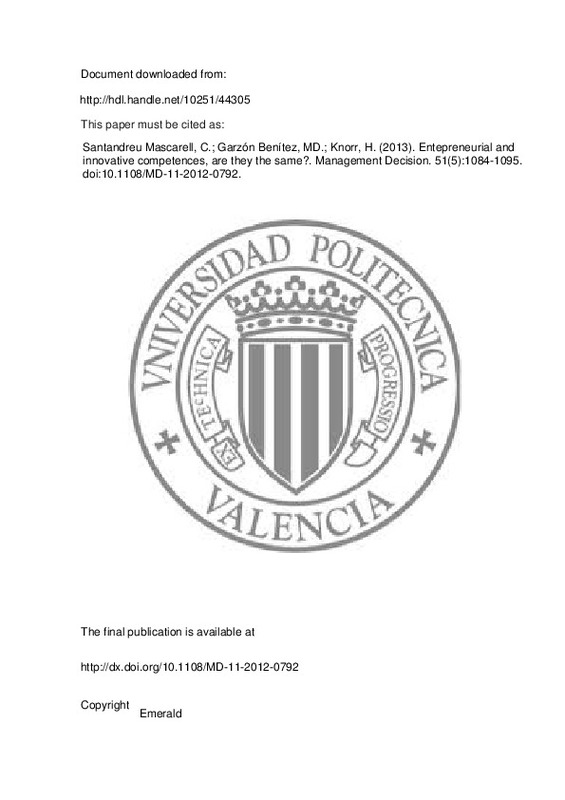Becherer, R.C. and Maurer, J.G. (1999), “The proactive personality disposition and entrepreneurial behaviour among small company presidents”,Journal of Small Business Management, Vol. 37 No. 1, pp. 28‐36.
Bergh, P., Thorgren, S., & Wincent, J. (2009). Entrepreneurs learning together: The importance of building trust for learning and exploiting business opportunities. International Entrepreneurship and Management Journal, 7(1), 17-37. doi:10.1007/s11365-009-0120-9
Bunk, G.P. (1994), “Teaching competence in initial and continuing vocational training in the Federal Republic of Germany”,Vocational Training European Journal, Vol. 1, pp. 8‐14.
[+]
Becherer, R.C. and Maurer, J.G. (1999), “The proactive personality disposition and entrepreneurial behaviour among small company presidents”,Journal of Small Business Management, Vol. 37 No. 1, pp. 28‐36.
Bergh, P., Thorgren, S., & Wincent, J. (2009). Entrepreneurs learning together: The importance of building trust for learning and exploiting business opportunities. International Entrepreneurship and Management Journal, 7(1), 17-37. doi:10.1007/s11365-009-0120-9
Bunk, G.P. (1994), “Teaching competence in initial and continuing vocational training in the Federal Republic of Germany”,Vocational Training European Journal, Vol. 1, pp. 8‐14.
Canina, L., Palacios, D., & Devece, C. (2010). Management theories linking individual and organizational level analysis in entrepreneurship research. International Entrepreneurship and Management Journal, 8(3), 271-284. doi:10.1007/s11365-010-0166-8
CHIESA, V. (1996). Development of a technical innovation audit. Journal of Product Innovation Management, 13(2), 105-136. doi:10.1016/0737-6782(95)00109-3
Choi, B., & Lee, H. (2003). An empirical investigation of KM styles and their effect on corporate performance. Information & Management, 40(5), 403-417. doi:10.1016/s0378-7206(02)00060-5
Cunningham, J.B. and Lischeron, J. (1991), “Defining entrepreneurship”,Journal of Small Business Management, Vol. 29 No. 1, pp. 45‐61.
Garzón, M. D. (2009). A comparison of personal entrepreneurial competences between entrepreneurs and CEOs in service sector. Service Business, 4(3-4), 289-303. doi:10.1007/s11628-009-0090-6
Glaser, B. (2002), “Conceptualization: on theory and theorizing using grounded theory”,International Journal of Qualitative Methods, Vol. 1 No. 2, available at: www.ualberta.ca/∼ijqm/.
Evans, D., & Volery, T. (2001). Online business development services for entrepreneurs: an exploratory study. Entrepreneurship & Regional Development, 13(4), 333-350. doi:10.1080/08985620110052274
Kreiser, P.M., Marino, L.D. and Weaver, K.M. (2002), “Assessing the psychometric properties of the entrepreneurial orientation scale: a multi‐country analysis”,Entrepreneurship: Theory and Practice, Vol. 26 No. 4, pp. 71‐95.
McClelland, D.C. (1962), “Business drive and national achievement”,Harvard Business Review, Vol. 40 No. 4, pp. 99‐112.
McClelland, D. C. (1965). N achievement and entrepreneurship: A longitudinal study. Journal of Personality and Social Psychology, 1(4), 389-392. doi:10.1037/h0021956
Marin‐Garcia, J.A., García‐Sabater, J.P. and Canós‐Darós, L. (2010), “Industrial engineering and the design of new European degrees”,Dirección y Organización, Vol. 40, pp. 35‐43.
Marin-Garcia, J. A., Garcia-Sabater, J. P., Perello-Marin, M. R., & Canos-Daros, L. (2009). Proposal of skills for the bachelor degree of Industrial Engineering in the context of the new curriculum. Intangible Capital, 5(4). doi:10.3926/ic.2009.v5n4.p387-406
Murillo, D., & Lozano, J. M. (2006). SMEs and CSR: An Approach to CSR in their Own Words. Journal of Business Ethics, 67(3), 227-240. doi:10.1007/s10551-006-9181-7
Nielsen, S. L., & Lassen, A. H. (2011). Identity in entrepreneurship effectuation theory: a supplementary framework. International Entrepreneurship and Management Journal, 8(3), 373-389. doi:10.1007/s11365-011-0180-5
Nissan, E., Galindo Martín, M.-Á., & Méndez Picazo, M.-T. (2011). Relationship between organizations, institutions, entrepreneurship and economic growth process. International Entrepreneurship and Management Journal, 7(3), 311-324. doi:10.1007/s11365-011-0191-2
Nonaka, I. (2000). A firm as a knowledge-creating entity: a new perspective on the theory of the firm. Industrial and Corporate Change, 9(1), 1-20. doi:10.1093/icc/9.1.1
Ortt, J. R., & Smits, R. (2006). Innovation management: different approaches to cope with the same trends. International Journal of Technology Management, 34(3/4), 296. doi:10.1504/ijtm.2006.009461
Quinn, J.B., Anderson, P. and Finkelstein, S. (1996), “La Gestión del Intelecto Profesional: Sacar el Máximo de los Mejores”,Harvard Deusto Business Review, Vol. 75, Noviembre‐Diciembre, pp. 4‐17.
Rothwell, R. (1992). Successful industrial innovation: critical factors for the 1990s. R&D Management, 22(3), 221-240. doi:10.1111/j.1467-9310.1992.tb00812.x
Santandreu-Mascarell, C., Canós-Darós, L., & Pons-Morera, C. (2011). Competencies and skills for future Industrial Engineers defined in Spanish degrees. Journal of Industrial Engineering and Management, 4(1). doi:10.3926/jiem.2011.v4n1.p13-30
Souitaris, V. (2002). Technological trajectories as moderators of firm-level determinants of innovation. Research Policy, 31(6), 877-898. doi:10.1016/s0048-7333(01)00154-8
ZHOU, Y., MINSHALL, T., & HAMPDEN-TURNER, C. (2010). BUILDING INNOVATION CAPABILITIES: AN INQUIRY INTO THE DYNAMIC GROWTH PROCESS OF UNIVERSITY SPIN-OUTS IN CHINA. International Journal of Innovation and Technology Management, 07(03), 273-302. doi:10.1142/s0219877010002082
Tajeddini, K., & Mueller, S. L. (2011). Corporate entrepreneurship in Switzerland: evidence from a case study of Swiss watch manufacturers. International Entrepreneurship and Management Journal, 8(3), 355-372. doi:10.1007/s11365-011-0179-y
Van Praag, C. M., & Versloot, P. H. (2007). What is the value of entrepreneurship? A review of recent research. Small Business Economics, 29(4), 351-382. doi:10.1007/s11187-007-9074-x
Verhees, F. J. H. M., & Meulenberg, M. T. G. (2004). Market Orientation, Innovativeness, Product Innovation, and Performance in Small Firms. Journal of Small Business Management, 42(2), 134-154. doi:10.1111/j.1540-627x.2004.00102.x
Zhou, Y., Minshall, T., & Turner, C. H. (2010). Entrepreneurial innovation problems associated with the dynamic growth of university spin-outs in China: a capabilities perspective. International Journal of Entrepreneurship and Innovation Management, 12(3/4), 330. doi:10.1504/ijeim.2010.035087
Zortea-Johnston, E., Darroch, J., & Matear, S. (2011). Business orientations and innovation in small and medium sized enterprises. International Entrepreneurship and Management Journal, 8(2), 145-164. doi:10.1007/s11365-011-0170-7
Hoffman, K., Parejo, M., Bessant, J., & Perren, L. (1998). Small firms, R&D, technology and innovation in the UK: a literature review. Technovation, 18(1), 39-55. doi:10.1016/s0166-4972(97)00102-8
Laforet, S., & Tann, J. (2006). Innovative characteristics of small manufacturing firms. Journal of Small Business and Enterprise Development, 13(3), 363-380. doi:10.1108/14626000610680253
Leiponen, A. (2005). Skills and innovation. International Journal of Industrial Organization, 23(5-6), 303-323. doi:10.1016/j.ijindorg.2005.03.005
Mohnen, P., & Röller, L.-H. (2005). Complementarities in innovation policy. European Economic Review, 49(6), 1431-1450. doi:10.1016/j.euroecorev.2003.12.003
[-]







![[Cerrado]](/themes/UPV/images/candado.png)


